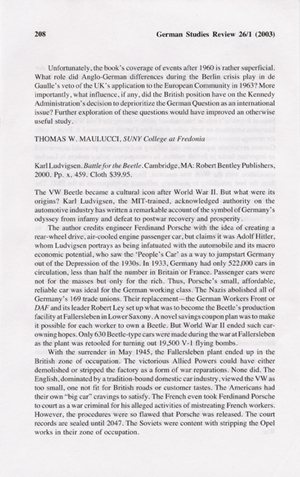|
|
Battle for the Beetle
Price: $64.95
|
German Studies Review - January 26, 2003
The VW Beetle became a cultural icon after World War II. But what were its origins? Karl Ludvigsen, the MIT-trained, acknowledged authority on the automotive industry has written a remarkable account of the symbol of Germany's odyssey from infamy and defeat to postwar recovery and prosperity.
The author credits engineer Ferdinand Porsche with the idea of creating a rear-wheel drive, air-cooled engine passenger car, but claims it was Adolf Hitler, whom Ludvigsen portrays as being infatuated with the automobile and its macro economic potential, who saw the 'People's Car' as a way to jumpstart Germany out of the Depression of the 1930s. In 1933, Germany had only 522,000 cars in circulation, less than half the number in Britain or France. Passenger cars were not for the masses but only for the rich. Thus, Porsche's small, affordable, reliable car was ideal for the German working class. The Nazis abolished all of Germany's 169 trade unions. Their replacement-the German Workers Front or DAF and its leader Robert Ley set up what was to become the Beetle's production facility at Fallersleben in Lower Saxony. A novel savings coupon plan was to make it possible for each worker to own a Beetle. But World War II ended such car-owning hopes. Only 630 Beetle-type cars were made during the war at Fallersleben as the plant was retooled for turning out 19,500 V-1 flying bombs.
With the surrender in May 1945, the Fallersleben plant ended up in the British zone of occupation. The victorious Allied Powers could have either demolished or stripped the factory as a form of war reparations. None did. The English, dominated by a tradition-bound domestic car industry, viewed the VW as too small, one not fit for British roads or customer tastes. The Americans had their own 'big car' cravings to satisfy. The French even took Ferdinand Porsche to court as a war criminal for his alleged activities of mistreating French workers. However, the procedures were so flawed that Porsche was released. The court records are sealed until 2047. The Soviets were content with stripping the Opel works in their zone of occupation.

Article from and courtesy of German Studies Review - January 26, 2003
![[B] Bentley Publishers](http://assets1.bentleypublishers.com/images/bentley-logos/bp-banner-234x60-bookblue.jpg)

